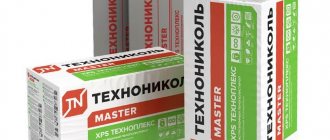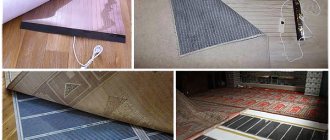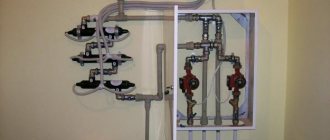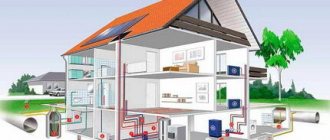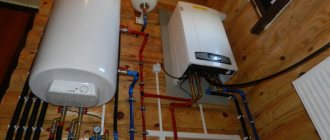Today we have to consider in detail the issue of arranging a heating system in a garage. Of course, maintaining the desired temperature level there is very important. Then you can work effectively. Some garage workers even organize real professional workshops. Of course, for their uninterrupted operation, regardless of the weather and time of year, you will need to install a boiler in the garage.
Let's find out what heating systems are available, what types of fuel are more economical to use, and what kind of boiler is best to install in the garage. Let's find out what car enthusiasts think about this, who have already assessed the pros and cons of different options personally.
Basic requirements for the heating system
First of all, you need to identify all the key requirements for heating in a garage. Let's list the main factors.
- It is important to make the heating system reliable, to ensure its resistance to sudden temperature fluctuations. Of course, most garages are not constantly heated. Consequently, the system will first heat up and then cool down greatly. These are significant additional loads.
- Please note that there is a high probability of frequent power outages. Here we are dealing not with a living space, but with a garage. And the electric heating system must be adapted to more difficult conditions.
- The optimal solution is to orient the heating system to operate in automatic mode. The automatic locking system must be activated in any emergency situation.
- Safety, especially in a garage, plays a huge role. In this room, fuels and lubricants, wheels and all kinds of spare parts and tire sets are stored. Of course, it is especially important to carefully follow fire safety rules.
- It is advisable to consider the efficiency of the heating system. Here you should try to maintain a balance of performance and cost so that heating is feasible from an economic point of view.
The heating boiler in the garage should work as efficiently as possible. To do this, it is imperative to minimize heat loss in the room. This is the only way to achieve better results. The building is well insulated and a sophisticated ventilation system is installed. It is also worth considering the optimal temperature for warming up the garage. In this room there is no need to achieve 18-20 degrees, as in a residential building. It is enough if the thermometer rises to 5-10 degrees Celsius.
Solid and liquid fuels and gas are used as fuel for boilers. You can install a water or electric heating system.
The main elements that contribute to the process of designing and landscaping the yard of a house
Arrangement of the yard of a private house begins directly with the project itself, after which estimates are drawn up and planned expenses are calculated. Then building materials, small architectural forms and planting material are purchased.
There are basic elements that should not be forgotten. These include the following components:
1. Buildings and structures. These elements are basic and dominant. On private territory there must be a house to live in, as well as some buildings: a garage, a bathhouse, an outbuilding (storage of work equipment, various accessories), a greenhouse, etc.
2. Road and path network. It divides all zones among themselves according to the functions they perform. When planning, you should lay all paths only along the shortest distance, which will save time when moving and financial resources for building materials.
The yard of a country house may also contain complex systems of paths with a variety of paving options.
3. Lighting – the presence of lighting devices is provided. It can be used not only for practical purposes, but also to create a beautiful decorative effect.
4. Flower beds – adding aesthetics to the area. Probably not a single owner can imagine how to arrange a yard without planting flower plants.
There are a huge number of such elements: a flower bed (a regular-shaped flower garden), a mixborder (a complex flower garden consisting of perennial flowers), a border (a flower garden along the paths), a rock garden, a rock garden (a complex flower garden that includes natural stones and various mountain plants), and other. This element will perfectly complement any area.
5. Small architectural forms. Thanks to them, you can distinguish which zone is which. These are various garden furniture, sculptures, fountains, lanterns and lamps.
6. Trees and shrubs. They can be planted in beautiful groups to create hedges and beautiful unique tapeworms. Thanks to proper planting, the creation of surprise in open views and their smooth transition into each other is guaranteed.
7. Ponds are an excellent element that will perfectly give a feeling of nature, naturalness and natural beauty. These can be small ponds, fountains, cascades and decorative waterfalls, streams and pools. They look very beautiful with natural stones and aquatic plants.
Thanks to proper planning of the territory and the presence of basic elements, your yard will be the most irresistible and beautiful, constantly attracting everyone's attention
Everyone living in a private house knows that a room is needed to store solid fuel for the winter. I suggest the option: “angle with a lifting roof.” This immediately begs the question: why with a lifting one? Based on my experience last year, when I had to throw coal into a coal pit, I realized that this is unpleasant work.
To make the square I needed:
profile pipe 20x40, 40x40, 50x50, 25x25 mm, door canopies, welding machine, electrodes, grinder, cutting discs for metal, level, tape measure, drill with drills, anchor bolts, pgs, cement, sand, concrete mixer.
To do this, I just needed to extend the parking area and I simply filled it and concreted it. On one side, instead of formwork, I laid out a brick “wall”, and on the other I laid an asbestos-cement pipe. Using anchors, I attached a “device” to the concrete base to hold the pillars, made from a 50x50 profile pipe, 200 mm long and a 3 mm thick metal plate with dimensions 150 x 150 mm.
What types of heating boilers are there?
Let's look at the types of heating boilers. In many ways, the efficiency and safety of the system as a whole depends on the boiler. Of course, it is quite possible to make a boiler for the garage yourself. But at the same time it must be safe, reliable, and ensure efficient operation. Comfort and simplicity of the boiler during operation also play a huge role.
We offer a classification of boilers according to fuel, the main source of thermal energy.
- Solid fuel boilers. An excellent modern option is pyrolysis boilers. They are recommended by many specialists and experienced garage workers. In such a cauldron, the wood does not burn, but slowly smolders. Wood begins to decompose when exposed to high temperatures. As a result, pyrolysis and a dry residue are formed. The pyrolysis gas is then burned. With this principle of operation of the boiler, wood lasts for a long time: fuel consumption is minimal, and heating efficiency is ensured. There is also a special buffer tank in which heat is accumulated. It is important to remember that in such a boiler, wood is suitable as fuel. For example, coal will no longer provide such a reaction. There are many solid fuel boilers, but it is the pyrolysis boiler that is so economical.
- Gas units. Here it is better to choose a condensing type boiler. It must be equipped with an automatic control system. The efficiency is quite high, and the low cost of fuel ensures the efficiency of the boiler. Good performance is possible even at low pressure. The release of thermal energy is observed when water transforms into liquid from steam. Experts note that condensing boilers are about 15% more economical than other types of gas units. The best option is to use a gas boiler with power modulation, which is mounted directly on the wall. It is convenient and easy to use.
- Electric boilers. Now in specialized stores you can choose almost any electric boiler from a wide range of models. There are various options. But first of all, it is important to reduce the load on the electrical network (since power surges are likely in the garage) and to provide conditions for efficient heating. You can choose a thyristor-controlled boiler equipped with six heating elements. The boiler is functional, safe, operates silently, and is very convenient to use. It is this kind of boiler that will minimize energy costs, since it allows you to regulate the power level. True, despite all the advantages, there is also a significant drawback associated with the high price of electricity.
There are also alternative heating options. Let’s say that boilers that operate on waste fuel are quite efficient and very economical. Next, we will consider all the important points in more detail.
How to heat so that coal burns as long as possible
The correct firing of a long-lasting coal boiler largely depends on the presence of control automation and, of course, the quality of the coal itself.
What coal is better to use
Manually operated boilers can operate on coal of any fraction. But it must be taken into account that the temperature of the gases in the chimney during long-term combustion is much lower than during direct combustion: the use of raw fuel can lead to the accumulation of excess moisture in the pipe and the formation of condensation - a black viscous liquid with a tar smell. Therefore, the relative humidity of coal (like any other solid fuel) should be no more than 15–20%.
Reference. Equipment with an automatic fuel supply function is more sensitive to the fraction, since it was originally developed for the 5–25 mm standard. In addition, it should be heated with low-caking (type 31 or 32) and low-ash (up to 15%) coal to avoid the appearance of excess “garbage” and a decrease in efficiency.
Correct firebox
The combustion of a long-burning boiler is carried out according to the following scheme:
- Fuel loading - the distributor is raised to its original position so that it is just above the loading door, and all the coal is immediately poured.
- Kindling - dry wood chips and paper are placed on top of the coal, after which they are ignited and burn with the top door open and the air duct closed.
- Combustion - when the temperature in the heat exchanger reaches 50-60 °C, the door closes tightly, then the telescopic air duct regulator opens.
- Temperature adjustment - the boiler automatically enters the optimal mode, but if necessary, the temperature is adjusted by the air duct damper.
Upon completion of the full combustion cycle, it is necessary to remove sintered pieces of coal from the loading chamber, clean the ash pan and fill in a new batch of fuel.
Heating options for permanent buildings
It is possible to significantly reduce heating costs if you have a permanent garage. It has significantly less loss of thermal energy, which guarantees higher heating efficiency and cost-effectiveness. It’s great if the garage is built of shell rock, brick or concrete.
Various options are used among garage workers. Air, water and solid fuel heating are praised. Of course, if we talk about installation and arrangement, air heating is noticeably more economical. However, first of all, it is worth thinking about how much money will then be spent directly on heating. After all, it is more logical to first invest a certain budget in order to quickly recoup it and save in the future. If we think from this position, it is better to choose water heating. It is more economical, and the system will be more durable and more resistant to wear.
Shed with a gable roof made of metal tiles
This barn was built alone. The construction is also frame: the cheapest way. In this case, the assembly method is “balloon” - gradual alignment of the racks. It all starts the same way: first we made columns for the foundation. Only this time they are brick.
Foundation for a barn made of brick pillars
As you can see, there are studs built into the corner posts. Holes are drilled in the strapping beam and it is put on studs. They can be done not only in corners, but also on intermediate posts: it will hold on more firmly.
This barn has a small porch-veranda, so a cross beam is installed at the required distance. And the wall will support it. Columns were also pre-made for it.
The logs were also attached to the plates
The logs can also be attached with a notch. Then a notch in the shape of the log is cut out in the strapping beam. In depth it should not exceed 30% of the thickness of the beam, so the joist is cut so that it is flush with the frame. This method is more labor-intensive.
Next, the frame was assembled: corner posts 100*100 mm, intermediate posts - 50*100 mm, the top frame and rafter system were assembled from the same board. The triangles at the top are reinforced with applied metal plates. Smaller plates were also attached at the junction of the upper frame beam and the racks. They were connected end-to-end without cutting, nailed on top and diagonally with nails. The plates reduced the likelihood of folding under lateral loads.
Next, the rafter system was assembled - a 150 * 50 mm board, on which - lathing for metal tiles. It was chosen because the dacha was roofed with the same material.
Assembled rafter system with sheathing
The frame was covered with OSB sheets - the most convenient size for construction. Subsequently, the walls will be finished with wood siding.
This is an almost finished barn with a gable roof. Wall decoration left
The sheathing, by the way, does not have to be made of plywood or OSB. You can attach the lining or board directly to the racks. But then, when assembling the frame, you need to install slopes: without the rigidity of the slab material, the building will be flimsy. If you don’t set the slopes, you can swing them by hand.
Such braces will give sufficient rigidity to the walls of the frame shed
After installing the braces, you can add boards, lining, block house, imitation timber, siding - the choice is yours.
Frame shed sheathed with boards
Similar frame sheds can be made from profile pipes. For strapping and corner posts, a cross-section of 60*60 mm or 60*40 mm is sufficient; for intermediate posts, even less - 20*40 will be normal. Only to attach the outer sheathing will you need to assemble and fasten the sheathing. Read more about building a shed from pipes and metal profiles here.
For those who are concerned about the appearance of the building, here are some ideas on how to make a barn beautiful in video format.
Solid fuel system
A good solution is to make a heating system with a boiler that will run on solid fuel: coal, wood. Simply put, it will be a stove. For example, the well-known “potbelly stove”. You can purchase it ready-made or make it yourself. For this purpose, metal profiles and pipes are used.
There is a more modern option - install a stove with convectors, long-burning. Now the Buleryan solid fuel boiler is growing in popularity. It is interesting that the heating system itself will be air, but the boiler will be solid fuel. Thermal energy is transferred due to the movement of heated air currents. Inertia remains low.
The big advantage of such a stove is that it quickly warms up the garage space. True, when the fuel is used up, the garage will soon cool down. The problem is low inertia.
If the goal is to achieve higher inertia of the heating system, it is worth making water heating based on a wood stove. Heating units must be installed around the entire perimeter of the room. The expansion tank is mounted inside, at the highest point of the heating system.
Garage workers use special volumetric tanks with a layer of thermal insulation. Such hydraulic accumulators significantly increase heat reserves. There is one more significant point: such heating systems must be filled not with plain water, but with antifreeze. This will prevent the liquid from freezing.
Some car enthusiasts install water heating systems on their own. It's economical and effective. You can stably maintain a comfortable temperature in the garage if it is well insulated.
How to reduce heat loss and not go broke?
No heating system will be profitable and efficient if care is not taken to reduce heat loss. Heaters will waste a huge amount of energy resources. This is expensive and impractical, so you will have to insulate the gates, walls, floor and roof.
You can use expanded clay, polystyrene concrete, foil insulation, but the cheapest and most versatile option is polystyrene foam. It is suitable for insulating all structural elements.
It can also be used for thermal insulation of the floor, provided that a floating screed is made: polystyrene foam does not tolerate mechanical stress well, so it is filled with cement.
The ceiling, walls and garage doors are covered with polystyrene foam. There are two options - external or external wall decoration. Both are equally effective and allow for excellent thermal insulation of the building. The choice should be based on the convenience of the garage owner himself.
Gas boiler for maximum efficient heating
Experts note the advantages and excellent technical characteristics of gas boilers. You can also make such a heating system yourself, without even involving specialists. True, it is advisable to work not with the main pipeline. Unfortunately, it is rarely possible to conduct gas from there. A good alternative is a modern gas boiler that runs on liquefied fuel.
You can easily choose the most suitable gas boiler for your garage. They are floor-mounted and wall-mounted and run on liquefied gas. The combustion chamber can be open or closed. Fuel consumption is low: to heat a garage with an area of 30 square meters, just one gas cylinder is enough for a month.
Let's look at the key features and advantages of garage heating boilers that run on liquefied gas.
- Compactness. This advantage of a gas boiler plays a big role in the garage, where there is always a shortage of free space. It is important to save literally every centimeter. And here it is gas boilers that are most convenient. For example, you can choose a compact wall-mounted boiler. It will be almost invisible in the garage.
- Reliability. Of course, in gas equipment, especially in a garage, the main emphasis must be on safety. Modern gas heating boilers make it possible to guarantee compliance with safety regulations at any time. If the permissible temperature of the coolant is exceeded or the draft is lost, the gas supply stops automatically.
- Durability. Gas boilers usually have a service life of more than ten years. But if we talk about practical use, the service life is much longer. The units actually have increased resistance to wear.
- Easy to install. Gas boilers are easy to install yourself. An excellent solution is to choose a model with a coaxial chimney. Then the installation process will be simplified as much as possible. You can also control the combustion of the gas itself.
- Versatility. There are such situations: at first there is no opportunity to connect to the main gas pipeline, and then it appears. In this case, owners of universal boiler models do not change them, but only slightly modify them. They operate on liquefied gas, and after a little optimization they begin to function on regular main gas.
- Connection to thermostat. This significant advantage will allow rational consumption of energy and fuel. When a specific model of gas boiler in the garage is connected to a thermostat, it is possible to constantly maintain the temperature at a minimum value, which guarantees savings.
There is also a drawback to gas boilers that run on liquefied gas from cylinders. It is extremely important to remember that storing and installing gas cylinders directly in the garage is strictly prohibited. You will need to organize a special place to store the cylinder outside the garage. Some garage workers set up small metal boxes and install gas cylinders there.
The best known manufacturers and models: characteristics and prices
Stropuva S15U
Stropuva (Stropuva) S15U with a power of 15 kW is a universal mine-type boiler that runs not only on coal, but also on wood, pellets and briquettes from any material. It is equipped with a bimetallic traction control, which eliminates the need to connect to the electrical network. Suitable for houses with an area of 100–120 m2.
Cost : 81,500–99,770 rubles.
Country of origin : Russia–Lithuania, STROPUVA LLC (STROPUVA).
Heiztechnik Q Alfa 15
Heiztechnik (Haytstechnik) Q Alfa 15 with a power of 15 kW - designed for heating a room with an area of 110–130 m2, burns coal, wood chips, various wood and briquettes. This Polish boiler is distinguished by a combination of cast iron grates and a body made of thick boiler steel (5 mm), which guarantees a long service life - up to 20 years.
Cost : 62,240–68,720 rubles.
Country of origin : Poland, HEIZTECHNIK LLC (HEIZTECHNIK).
Buderus Logano S181-15E
Buderus Logano S181-15E with a power of 15 kW is one of the best long-burning coal boilers for heating a private house with an area of 120–140 m2. The basic package includes water and gas temperature sensors, as well as a spacious hopper (240 l), thanks to which the device operates for 3-5 days in a row.
Cost : 218,000–250,640 rubles.
Country of origin : Germany, BOSCH LLC (BOSH THERMOTECHNIKA).
WEEK KO-60
WEEK KO-60 with a power of 60 kW is a highly efficient domestically produced model capable of heating a house of 200–250 m2 for 2–4 days using one bed of coal. Its microprocessor unit is not sensitive to power failures, and when turned off, the boiler simply goes out slowly (6–12 hours).
Cost : 115,900–130,500 rubles.
Country of origin : Russia (Kemerovo), TRIAY LLC.
TIS PRO 11
TIS (TIS) PRO 11 with a power of 11 kW is a compact unit that is well suited for heating a small private house, cottage or cottage of 80–100 m2. Air supply adjustment can be manual (using a bolt on the door) or automatic (using a mechanical thermostat) - your choice.
Cost : 64,100–67,200 rubles.
Country of origin : Belarus, BelKomin LLC TIS Group (TIS Group).
LIEPSNELE L20U
LIEPSNELE (Liepsnele) L20U with a power of 20 kW is a non-volatile boiler for a house of 150–180 m2, has a capacious loading chamber (320 l), which ensures the burning duration of one load of up to 6–7 days. It is practically “omnivorous”: it can be heated with coal, wood, sawdust, shavings, pellets and even peat.
Cost : 85,400–90,560 rubles.
Country of origin : Lithuania, LLC "VAKARO RASA" (VAKARO RASA).
Electric heating in garage
Quite often in garages you can find electric air heating. Here, electric convectors are used to generate thermal energy. This type of heating functions well autonomously. It is possible to constantly maintain a certain temperature in the garage. But still, there is a big disadvantage: the inertia is low, which is why the room instantly cools down if the heating stops.
Electric boiler for garage
Among a wide range of modern electric boilers, you can choose a model with optimal power, taking into account the area of the garage. The range is impressive: there are models for heating a garage with an area of 30 square meters, and boilers designed for 600 square meters are also presented. At the same time, the price of a ready-made branded boiler is quite affordable: it starts from only 6 thousand rubles.
Let us dwell on the key advantages of electric heating boilers.
- Compactness. Such a unit can be easily placed even in a small garage.
- Reliability. The equipment works without failures.
- Automation of work. Since power outages often occur in garages, this factor plays a huge role. Even if there is a short-term power outage, the heating system will start working again automatically when the electricity is connected.
- Versatility. There is no need to install a chimney.
- High level of security. It is also extremely important to provide everything in a garage from a safety point of view. This is especially important since flammable materials are stored here. The boiler has a special security system. It turns on when the coolant overheats.
An electric boiler, despite the fairly high cost of energy, still allows you to spend money efficiently. Only the garage room must be well insulated. In addition, only with an electric boiler was it possible to ensure safety at such a decent level. There is no need for the constant presence of a person in the garage or personal control.
Modern technologies have even made it possible to control the operation of a garage's electric heating system from a distance. You can install an electric boiler with a GSM module in the garage, and control its operation using a regular mobile phone.
Water heating: adjustable power
First of all, when carrying out water heating, it is necessary to make the system reliable. At the same time, experts note that it is advisable to install the heating boiler closer to the garage. A good solution is to purchase a powerful pump in advance, and also take care of insulating the coolants, that is, the pipeline. Power is calculated as follows. If the garage has an area of 15-20 square meters, a boiler with a power of 1.5-2 kW will be sufficient. At the same time, it is worth remembering about frequent disconnections from the network and the high price of electricity.
Advantages of brick heat source
Installing a solid fuel boiler is easier and cheaper than building a brick heating stove in the middle of the house. On the other hand, for the unit to operate, it is necessary to install a water heating system, and the stove can do without it.
Despite the high cost and complexity of construction, many homeowners still prefer brick ovens. The reasons are significant:
Features of placing the stove in the house.
- Durability. When coal is burned in the firebox of any heater, a fairly high temperature arises, which over time destroys steel products. While even ordinary ceramic bricks will last for decades.
- Cast iron boiler heat exchangers run the risk of cracking due to temperature changes, while brickwork can easily withstand temperature shock.
- Heat capacity. A brick stove on coal accumulates a large amount of heat during operation, and the boiler for this requires a buffer tank, which costs a lot of money.
- The accumulated heat is released into the room for a long time after the coal in the combustion chamber has died out.
- The stove produces healthy, pleasant heat transmitted through infrared radiation and convection.
Since coal stoves still cannot do without the firewood required for kindling and heating, an indescribable atmosphere is created in the house, saturated with the natural smells of nature. There are 2 types of such heat sources:
Spent fuel
Used engine oil can also be an excellent fuel for a special boiler. This method is attractive for its efficiency, since fuel costs are extremely reduced. Just a liter of fuel takes an hour. One important point to remember is that the oil must be cleaned before use. There are special fuel installations where it is purified. The installation with the boiler is assembled independently.
Look at the diagram: it’s not at all that difficult to understand the structure of such a system and make it yourself. If it’s difficult to visualize everything clearly, you can additionally watch an informative video.
Construction of a coal furnace
Before construction begins, each owner will choose his own design option. Some will prefer to install a long-burning coal stove in their home, while others will opt for the economical “baby” or “housekeeper” option. But for each of the available options, the sequence of construction work remains unchanged.
If you don’t know where to start working on the construction of a furnace, and the materials and tools have already been selected, then the first thing you need to do is prepare the construction site. To do this, you will have to clean it of foreign objects and debris. Then, if the stove is being built indoors, you need to remove the floor covering, which is an unreliable combustible material and is not suitable for the base of the stove.
When constructing a coal furnace for a long time, even if the most economical and lightweight design option is chosen, one must not forget about a reliable foundation. It is this that will prevent the stove from sinking into the ground over time or changing its geometric dimensions due to the lowering of one of the corners. The foundation must be made reliable and solid, then if it is necessary to change the configuration of the furnace or modernize it, you will not have to deal with it again.
When the site and foundation of the future furnace are ready, its serial construction can begin. The ordering scheme can be taken from open sources. It is this that will not allow a novice specialist to make mistakes when constructing load-bearing walls and internal lintels.
When the coal stove is folded, it is necessary to make a chimney for it. Here you will have to apply all the knowledge accumulated by your ancestors and modern developments, because the chimney will essentially be constantly open and it is necessary to prevent rapid cooling of the room and reverse draft. The basis of the chimney of a coal furnace should be a horizontal or vertical chimney, which will reduce the speed of the flue gases and allow the furnace body to receive additional heat from them.
When building a coal furnace, special attention must be paid to its safe operation, and the space in front of the firebox on the combustible floor covering should be covered as much as possible with metal material
The versatility of a solid fuel boiler
Solid fuel boilers and systems based on them are attractive primarily for their autonomy. They allow you to provide uninterrupted heating, which will not depend on the electrical network or gas mains. The simplest stove can be loaded with firewood, sawdust, and coals. Such fuel does not require significant costs.
At the same time, almost every car enthusiast, if desired, will be able to quickly and easily make a stove like a “stove stove” with his own hands. Few materials are required either. It is not necessary to have a large budget to make a stove with a chimney or organize an exhaust system.
Remember that fire safety techniques will always occupy a central place. This is especially important in a garage. In addition, stoves and chimneys, solid fuel boilers must be cleaned regularly.
Making a device yourself
Carrying out brickwork is quite a difficult job if you lack experience. Therefore, before starting construction, it is better to seek advice from a master
When making a stove yourself, it is important to carefully follow all the steps and not change the chosen design scheme
Project selection, drawings
The choice of oven model is primarily influenced by the desired power of the device. The efficiency of the heater depends on the size of the combustion chamber. Typically, coal combustion has a heat output of about 500 kcal/hour. Therefore, a device of standard dimensions 110cmx90cm is suitable for heating a room up to 35 square meters. m.
Photo 1. Drawing of a metal coal stove. The device is small in size, it will fit even in small rooms.
Photo 2. Drawing of a coal stove made of metal. Arrows also indicate all parts of the device.
Materials and tools
To build a coal stove, you will need fireclay bricks that can withstand heating up to 1400-1650 degrees without cracking. To prepare masonry mortar, fatty clay is used mixed with water and sand. To lay out the external walls you will need solid red brick.
Doors, hinges, and grate are purchased at a hardware store.
The work will also require tools: hammers, a trowel, usually a mortar shovel, a hacksaw, a grinder, a building level, plumb lines, and a tape measure.
Stages of work
When choosing a place to build a stove, factors such as the location of the chimney and the size of the room are taken into account (in a large area it is better to install the equipment in the center).
The walls and ceiling in the selected area are sheathed with fire-resistant material.
It is better to immediately think about the place where the coal will be stored - in order to avoid fire hazards, it should not be placed in close proximity to the stove. It is also necessary to take into account that coal is very dusty and dirty.
A massive brick oven is installed only on a concrete foundation, which is not connected to the main one. Therefore, its location is better than
Recommendations for masonry
To lay a stove where you plan to burn coal, you will need 2 types of mortar - clay-sand and fireproof. With the help of the first, the body of the furnace is built from solid ceramic bricks, and the second is used for the internal masonry of fireclay stones. The thickness of the seams also differs: for ordinary masonry it is a maximum of 5 mm, for fireproof masonry - 3 mm.
To prepare both types of mortar, it is recommended to purchase ready-made construction mixtures that are commercially available. Only experienced stove makers can make a good solution from natural clay. You also need to prepare masonry and measuring tools, and then start building the stove:
The stove solution does not harden, but dries, for which it needs to be given 2-3 days. Afterwards, all that remains is to lay out the chimney, observing the rules for passing through the floors and roof, and at the end make a test firebox. You can fill the stove with coal only after it has completely warmed up, making sure that there are no cracks or crevices.
This site uses Akismet to reduce spam. Find out how your comment data is processed.
Coal stove diagram for home
The design of a brick coal stove is almost no different from the design of a conventional wood stove.
It consists of, located in a certain sequence: foundation, ash pit, combustion chamber, vault, chimney.
The main difference between a coal stove is a reinforced firebox and an increased volume of the ash pan (when burning coal, a larger amount of ash is produced than when burning wood).
A larger area grate is also required (ideally it replaces the bottom of the firebox).
The coal in the combustion chamber of the furnace burns out from below, so the walls of the compartment are made inclined - this design helps the upper layers of coal to sink as they burn out. The dimensions of the standard device are 110x900cm, the height without a chimney is about a meter.

